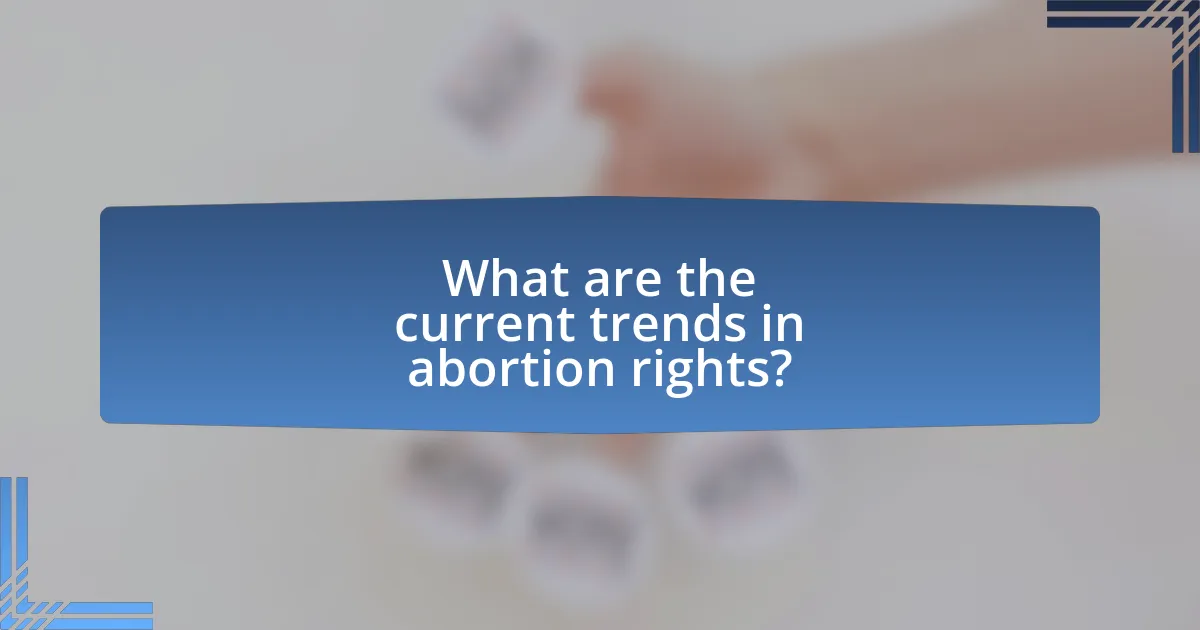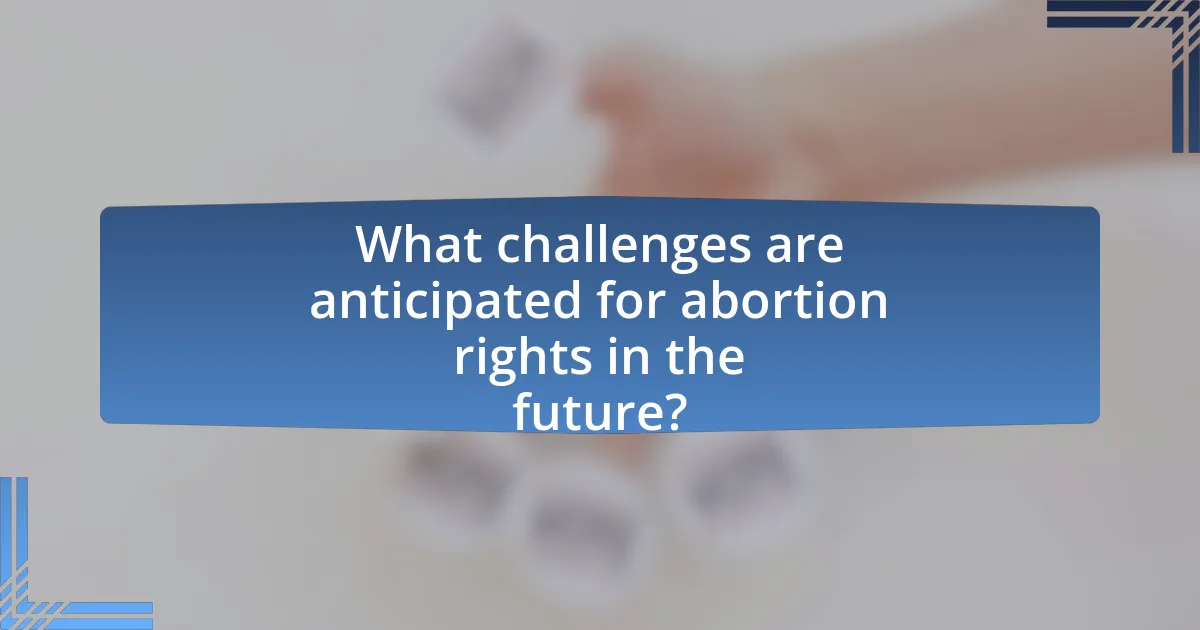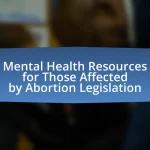The article examines the current trends and future predictions regarding abortion rights, highlighting the significant polarization in legislation across various regions, particularly in the United States. Following the Supreme Court’s 2022 decision to overturn Roe v. Wade, many states have enacted stricter abortion laws, while others have moved to protect and expand access. The article discusses recent legal changes, societal factors influencing public opinion, the role of advocacy groups, and the impact of upcoming elections on abortion legislation. Additionally, it explores anticipated challenges, emerging social movements, and practical steps individuals can take to support abortion rights.

What are the current trends in abortion rights?
Current trends in abortion rights indicate a significant polarization in legislation across different regions. In the United States, following the Supreme Court’s decision to overturn Roe v. Wade in 2022, many states have enacted stricter abortion laws, while others have moved to protect and expand access to abortion services. For instance, states like California and New York have implemented measures to safeguard abortion rights, contrasting sharply with states such as Texas and Alabama, which have imposed severe restrictions. Additionally, public opinion is increasingly supportive of abortion rights, with recent polls showing that a majority of Americans believe abortion should be legal in most cases. This divergence in state laws and shifting public sentiment reflects a broader trend of activism and legal battles surrounding reproductive rights, emphasizing the ongoing debate and its implications for the future of abortion access.
How have recent legal changes impacted abortion rights?
Recent legal changes have significantly restricted abortion rights in various jurisdictions, particularly following the U.S. Supreme Court’s decision in June 2022 to overturn Roe v. Wade. This ruling allowed individual states to implement their own abortion laws, leading to a wave of legislation that has resulted in bans or severe limitations on abortion access in numerous states. For instance, as of October 2023, over 20 states have enacted laws that either ban abortion outright or impose strict gestational limits, reflecting a substantial shift in the legal landscape surrounding reproductive rights. These changes have created disparities in access to abortion services, disproportionately affecting low-income individuals and marginalized communities, as they often lack the resources to travel to states with more permissive laws.
What specific laws have been enacted or repealed recently?
Recently, several specific laws related to abortion rights have been enacted or repealed across various states in the United States. For instance, in 2023, states like Florida and North Carolina enacted laws that restrict abortion access, limiting procedures after six weeks of pregnancy. Conversely, states such as California and New Jersey have enacted laws to protect and expand abortion rights, ensuring access to services regardless of federal changes. These legislative actions reflect ongoing trends in the political landscape surrounding abortion rights, with states taking divergent paths in response to public opinion and judicial rulings.
How do these changes vary by region or country?
Abortion rights changes vary significantly by region and country, influenced by cultural, legal, and political factors. For instance, in North America, particularly the United States, recent Supreme Court decisions have led to stricter regulations in several states, while others, like California and New York, have expanded access. In contrast, many European countries, such as France and Germany, maintain relatively liberal abortion laws, allowing access up to 12 weeks of pregnancy. In Latin America, countries like Argentina have recently legalized abortion, while others, such as El Salvador, impose strict bans. These variations highlight the complex landscape of abortion rights globally, shaped by local governance and societal attitudes.
What societal factors are influencing abortion rights?
Societal factors influencing abortion rights include cultural beliefs, political climate, and socioeconomic status. Cultural beliefs shape public opinion on abortion, with varying attitudes based on religious and ethical perspectives; for instance, in predominantly conservative regions, opposition to abortion is often stronger. The political climate significantly impacts legislation, as seen in the United States where shifts in government leadership can lead to changes in abortion laws, such as the overturning of Roe v. Wade in 2022, which resulted in numerous states enacting restrictive measures. Socioeconomic status also plays a crucial role, as individuals from lower-income backgrounds may face greater barriers to accessing abortion services, highlighting disparities in healthcare access. These factors collectively influence the ongoing discourse and legal landscape surrounding abortion rights.
How do public opinions shape abortion legislation?
Public opinions significantly shape abortion legislation by influencing lawmakers’ decisions and public policy. When a majority of the population supports or opposes abortion rights, elected officials often align their legislative actions with these views to secure votes and maintain public approval. For instance, surveys conducted by organizations like Gallup have shown that public support for abortion rights fluctuates, impacting legislative outcomes in various states. In 2021, a Gallup poll indicated that 58% of Americans identified as pro-choice, which led to increased advocacy for protective abortion laws in several jurisdictions. Conversely, in areas where anti-abortion sentiment is strong, such as certain Southern and Midwestern states, legislation has increasingly restricted access to abortion services. This dynamic illustrates how public sentiment directly correlates with the legal landscape surrounding abortion.
What role do advocacy groups play in the abortion rights movement?
Advocacy groups play a crucial role in the abortion rights movement by mobilizing public support, influencing policy, and providing resources for individuals seeking reproductive health services. These organizations, such as Planned Parenthood and the National Abortion Federation, engage in grassroots campaigns to raise awareness about reproductive rights and educate the public on the importance of access to safe and legal abortion. They also lobby lawmakers to protect and expand abortion rights, as evidenced by their involvement in legislative battles and court cases that shape abortion laws across the United States. Additionally, advocacy groups offer financial assistance, counseling, and medical referrals to individuals facing barriers to abortion access, demonstrating their commitment to supporting reproductive autonomy.

What predictions can be made about the future of abortion rights?
Predictions about the future of abortion rights indicate a potential increase in state-level restrictions and a corresponding rise in advocacy for reproductive rights. Following the Supreme Court’s decision in 2022 to overturn Roe v. Wade, many states have enacted stricter abortion laws, suggesting a trend toward localized control over abortion access. For instance, as of 2023, over 20 states have implemented significant restrictions or bans on abortion, reflecting a shift in the legal landscape. Concurrently, public opinion polls show a majority of Americans support maintaining access to abortion, which may drive grassroots movements and legislative efforts to protect reproductive rights in various jurisdictions. This dual trend of increasing restrictions alongside rising advocacy efforts suggests a contentious future for abortion rights, characterized by ongoing legal battles and public discourse.
How might upcoming elections affect abortion legislation?
Upcoming elections can significantly influence abortion legislation by determining the composition of legislative bodies and the executive branch. When pro-choice candidates gain seats, they are more likely to support and enact laws that protect and expand abortion rights, as seen in states like California and New York, where Democratic majorities have strengthened access to abortion services. Conversely, if pro-life candidates win, they may push for restrictive laws, similar to the recent trends in states like Texas and Alabama, where Republican-led legislatures have enacted stringent abortion bans. The outcomes of these elections directly correlate with the legislative priorities and policies that will shape the future of abortion rights in the United States.
What trends are emerging in political platforms regarding abortion?
Emerging trends in political platforms regarding abortion include a shift towards more restrictive laws in several states, alongside a growing emphasis on reproductive rights among progressive parties. Many conservative platforms are advocating for stricter regulations, including gestational limits and mandatory waiting periods, reflecting a national trend towards limiting access. Conversely, progressive platforms are increasingly promoting policies that protect and expand access to abortion services, often in response to recent legislative changes in states like Texas and Alabama. This duality highlights a polarized political landscape, where states are becoming battlegrounds for abortion rights, with some enacting protective measures while others impose restrictions.
How could shifts in political power influence abortion rights?
Shifts in political power can significantly influence abortion rights by altering the legislative landscape and judicial interpretations surrounding the issue. For instance, when a political party that supports restrictive abortion laws gains power, it may enact legislation that limits access to abortion services, as seen in various U.S. states following the 2016 elections where Republican majorities passed numerous abortion restrictions. Conversely, a shift towards a party that advocates for reproductive rights can lead to the expansion of access and protections for abortion, exemplified by states like California and New York enacting laws to safeguard abortion rights in response to federal threats. Historical trends indicate that political control directly correlates with the legal status and accessibility of abortion services, demonstrating the profound impact of political power dynamics on reproductive rights.
What technological advancements could impact abortion access?
Telemedicine and digital health technologies significantly impact abortion access by enabling remote consultations and medication prescriptions. These advancements allow individuals to receive care without needing to travel to a clinic, which is particularly beneficial in areas with limited access to healthcare facilities. For instance, a study published in the American Journal of Public Health found that telemedicine can increase access to medication abortion, especially in rural regions where clinics may be scarce. Additionally, advancements in mobile health applications facilitate information dissemination and support, empowering individuals to make informed decisions about their reproductive health.
How might telemedicine change the landscape of abortion services?
Telemedicine may significantly change the landscape of abortion services by increasing access to care, particularly in underserved areas. By allowing patients to consult healthcare providers remotely, telemedicine can reduce barriers such as travel distance and clinic availability. A study published in the American Journal of Public Health found that telehealth services for medication abortion can be as safe and effective as in-person visits, with a 99% success rate. This shift could lead to more individuals being able to obtain abortion services discreetly and conveniently, ultimately transforming how reproductive healthcare is delivered.
What role does digital information play in shaping public awareness?
Digital information significantly influences public awareness by providing immediate access to diverse perspectives and facts. This accessibility allows individuals to stay informed about critical issues, such as abortion rights, through various platforms like social media, news websites, and blogs. For instance, a Pew Research Center study found that 64% of Americans use social media to get news, highlighting its role in shaping opinions and awareness on topics like reproductive rights. Additionally, digital campaigns can mobilize public opinion and drive advocacy efforts, as seen in movements that have successfully raised awareness and influenced legislation regarding abortion.

What challenges are anticipated for abortion rights in the future?
Anticipated challenges for abortion rights in the future include increased legislative restrictions, potential judicial rollbacks, and societal polarization. Legislative bodies in various states are likely to introduce more restrictive laws, as evidenced by the surge in state-level abortion bans following the Supreme Court’s decision in Dobbs v. Jackson Women’s Health Organization in 2022. Judicial rollbacks may occur if courts interpret constitutional rights in ways that limit access to abortion services, similar to past rulings that have undermined reproductive rights. Additionally, societal polarization surrounding the issue may lead to heightened activism on both sides, complicating the political landscape and influencing public policy decisions.
What legal battles are likely to arise in the coming years?
Legal battles likely to arise in the coming years will center around state-level abortion restrictions and challenges to federal protections. Following the Supreme Court’s decision in Dobbs v. Jackson Women’s Health Organization, which overturned Roe v. Wade, numerous states have enacted or are considering stricter abortion laws. These laws will likely face legal challenges based on constitutional rights, women’s health, and privacy issues. For instance, cases challenging Texas’ Senate Bill 8, which allows private citizens to sue anyone who performs or aids an abortion, exemplify the contentious legal landscape. Additionally, states with trigger laws that ban abortion immediately after the overturning of Roe are expected to face lawsuits from advocacy groups and healthcare providers, arguing that such laws violate established legal precedents and infringe on individual rights.
Which states are expected to challenge existing abortion laws?
States expected to challenge existing abortion laws include Texas, Florida, and Ohio. These states have recently enacted restrictive abortion legislation and are likely to face legal challenges from advocacy groups and opposing state officials. For instance, Texas has implemented laws that significantly limit access to abortion, prompting organizations like Planned Parenthood to initiate lawsuits aimed at overturning these regulations. Similarly, Florida’s recent legislative actions have drawn scrutiny and potential legal opposition, indicating a trend of challenges in states with stringent abortion laws.
How might Supreme Court decisions influence future cases?
Supreme Court decisions set legal precedents that significantly influence future cases by establishing interpretations of the law that lower courts must follow. For instance, the 1973 decision in Roe v. Wade established a constitutional right to abortion, which shaped subsequent rulings and state laws regarding reproductive rights. When the Supreme Court revisits or overturns such precedents, as seen in the 2022 Dobbs v. Jackson Women’s Health Organization case, it can lead to widespread changes in legal interpretations and state regulations, thereby affecting future cases related to abortion rights and other constitutional issues.
What social movements could emerge in response to changes in abortion rights?
Social movements that could emerge in response to changes in abortion rights include reproductive justice movements, pro-choice advocacy groups, and anti-abortion activism. Reproductive justice movements focus on the intersection of reproductive rights with social justice issues, advocating for comprehensive access to healthcare, including abortion, particularly for marginalized communities. Pro-choice advocacy groups may mobilize to protect and expand abortion access, especially in regions where rights are being restricted, as seen in the aftermath of the 2022 U.S. Supreme Court decision in Dobbs v. Jackson Women’s Health Organization, which overturned Roe v. Wade. Conversely, anti-abortion activism could intensify, with groups seeking to promote legislation that further restricts access to abortion services, reflecting a historical trend where significant legal changes often galvanize opposition movements.
How might grassroots activism evolve in the future?
Grassroots activism is likely to evolve through increased digital engagement and the use of social media platforms for mobilization. As technology advances, activists will leverage data analytics to identify key demographics and tailor their messages effectively, enhancing outreach and participation. For instance, the rise of platforms like TikTok has already shown how younger generations can be mobilized quickly around social issues, including abortion rights. Additionally, the integration of virtual reality and augmented reality in campaigns may create immersive experiences that deepen public understanding and empathy regarding abortion rights. Historical trends indicate that movements with strong online presences, such as the Women’s March, have successfully galvanized support and influenced policy changes, demonstrating the potential for future grassroots activism to harness technology for greater impact.
What strategies are being developed to counteract restrictive laws?
Strategies being developed to counteract restrictive laws include legal challenges, public awareness campaigns, and legislative advocacy. Legal challenges involve filing lawsuits against states implementing restrictive measures, as seen in cases like Whole Woman’s Health v. Hellerstedt, which successfully struck down Texas laws that imposed undue burdens on abortion providers. Public awareness campaigns aim to educate the public about reproductive rights and mobilize grassroots support, exemplified by organizations like Planned Parenthood, which actively engage communities through outreach and education. Legislative advocacy focuses on promoting pro-choice legislation at state and federal levels, with initiatives such as the Women’s Health Protection Act, which seeks to safeguard access to abortion nationwide. These strategies collectively aim to protect and expand abortion rights in response to increasing restrictions.
What practical steps can individuals take to support abortion rights?
Individuals can support abortion rights by actively participating in advocacy efforts, such as joining local or national organizations that promote reproductive rights. Engaging in grassroots campaigns, attending rallies, and contacting elected officials to express support for pro-choice legislation are effective actions. For instance, the Guttmacher Institute reports that public support for abortion rights has increased, indicating a growing movement that individuals can join to amplify their voices. Additionally, donating to organizations that provide abortion services or support women in need can directly impact access to care.


